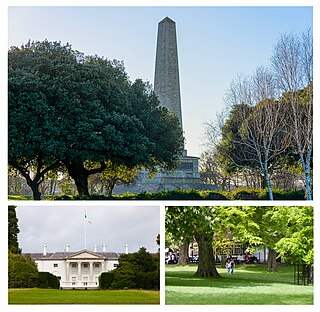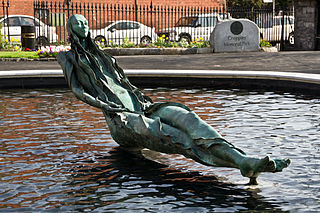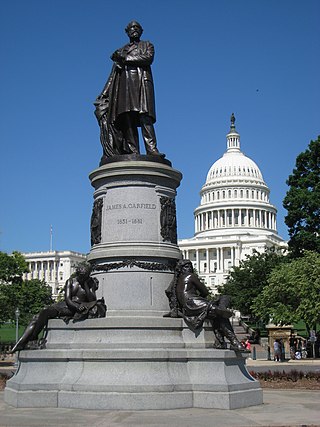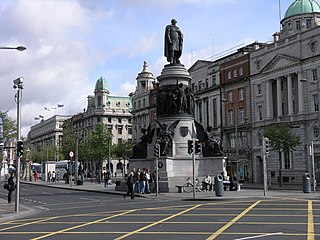
The Phoenix Park is a large urban park in Dublin, Ireland, lying 2–4 kilometres (1.2–2.5 mi) west of the city centre, north of the River Liffey. Its 11 kilometres (6.8 mi) perimeter wall encloses 707 hectares of recreational space. It includes large areas of grassland and tree-lined avenues, and since the 17th century has been home to a herd of wild fallow deer. The Irish Government is lobbying UNESCO to have the park designated as a World Heritage Site.

Merrion Square is a Georgian garden square on the southside of Dublin city centre.

St Stephen's Green is a garden square and public park located in the city centre of Dublin, Ireland. The current landscape of the park was designed by William Sheppard. It was officially re-opened to the public on Tuesday, 27 July 1880 by Lord Ardilaun. The square is adjacent to one of Dublin's main shopping streets, Grafton Street, and to a shopping centre named after it, while on its surrounding streets are the offices of a number of public bodies as well as a stop on one of Dublin's Luas tram lines. It is often informally called Stephen's Green. At 22 acres (8.9 ha), it is the largest of the parks in Dublin's main Georgian garden squares. Others include nearby Merrion Square and Fitzwilliam Square.

Anna Livia is a bronze monument located in Croppies' Acre Memorial Park in Dublin, Ireland. It was formerly located on O'Connell Street.

Wellington's Column, or the Waterloo Memorial, is a monument to the Duke of Wellington standing on the corner of William Brown Street and Lime Street, Liverpool, Merseyside, England. It is recorded in the National Heritage List for England as a designated Grade II* listed building.

The James A. Garfield Monument stands on the grounds of the United States Capitol in the traffic circle at First Street and Maryland Avenue SW in Washington, D.C. It is a memorial to U.S. President James A. Garfield, who was elected in 1880 and assassinated in 1881 after serving only four months of his term. The perpetrator was an attorney and disgruntled office-seeker named Charles J. Guiteau. Garfield lived for several weeks after the shooting, but eventually succumbed to his injuries. The monument is part of a three-part sculptural group near the Capitol Reflecting Pool, including the Peace Monument and the Ulysses S. Grant Memorial in Union Square. The monument is also a contributing property to the National Mall and L'Enfant Plan, both of which are listed on the National Register of Historic Places and the District of Columbia Inventory of Historic Sites. The bronze statue rests on a granite pedestal that features three sculptures, each one representing a time period in Garfield's life.

Nelson's Pillar was a large granite column capped by a statue of Horatio Nelson, built in the centre of what was then Sackville Street in Dublin, Ireland. Completed in 1809 when Ireland was part of the United Kingdom, it survived until March 1966, when it was severely damaged by explosives planted by Irish republicans. Its remnants were later destroyed by the Irish Army.
John Bowden was an Irish architect and member of the Board of First Fruits of the Church of Ireland from 1813 to 1821. He was born in Dublin and died in 1822.

Freedom Monument is a monument in Bydgoszcz commemorating both the fallen Soviet and Polish soldiers who fought during the liberation of the city in January 1945, and the return of Bydgoszcz to Poland on 20 January 1920.

The equestrian statue of the Duke of Wellington is an outdoor sculpture of Arthur Wellesley, 1st Duke of Wellington, a British soldier and statesman, located at the Royal Exchange in London. It overlooks Bank junction in the historic City of London. The sculptor was Francis Leggatt Chantrey. The statue commemorates Wellington's assistance to the City of London in ensuring that a bill was passed to allow the rebuilding of London Bridge.

The Oscar Wilde Memorial Sculpture is a collection of three statues in Merrion Square in Dublin, Ireland, commemorating Irish poet and playwright Oscar Wilde. The sculptures were unveiled in 1997 and were designed and made by Danny Osborne.

The Equestrian statue of George I, by John van Nost the Elder, is a statue that stands outside the Barber Institute of Fine Arts in Birmingham, England.

Monumento a la Mujer is a bronze statue commemorating the contributions of the Puerto Rican women to the Puerto Rican society. It is located at the fork of Calle Marina and Calle Mayor Cantera, in Ponce, Puerto Rico, next to Parque Urbano Dora Colón Clavell, in Barrio Cuarto. It was unveiled in 2002. Its sculptor was Maria Elena Perales. The monument was the first and, at the time, the only one of its kind "in Puerto Rico and the Caribbean."

The King John III Sobieski Monument in Gdańsk is an equestrian statue of the King of Poland John III Sobieski (1629-1696). Originally built in Lviv in 1898, the monument was transferred to Gdańsk in 1965.

The Benavides Monument is a memorial in the University of Santo Tomas in Manila, Philippines built to commemorate the founder of the University of Santo Tomas, Miguel de Benavides. Located in the Plaza Benavides in front of the UST Main Building, the monument consists of a bronze statue of Benavides rising on top of a granite pedestal. The present monument was unveiled in 1946.

Beresford Place is a street in Dublin, Ireland originally laid out as a crescent surrounding The Custom House in 1792.

Major General David McMurtrie Gregg is a monumental statue located in Reading, Pennsylvania, United States. The monument was designed by Henry Augustus Lukeman and consists of an equestrian statue depicting David McMurtrie Gregg, a military officer who had served in the Union Army during the American Civil War. The monument was dedicated in 1922, several years after Gregg's death in Reading in 1916.

The O'Connell Monument, colloquially known as The Angels is a 40ft high commemorative granite and bronze monument located on O'Connell Street, the main thoroughfare of Dublin, Ireland, honouring nationalist leader Daniel O'Connell (1775-1847).

























